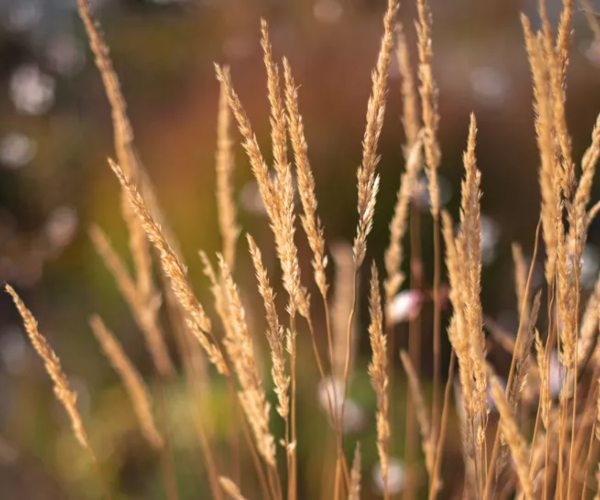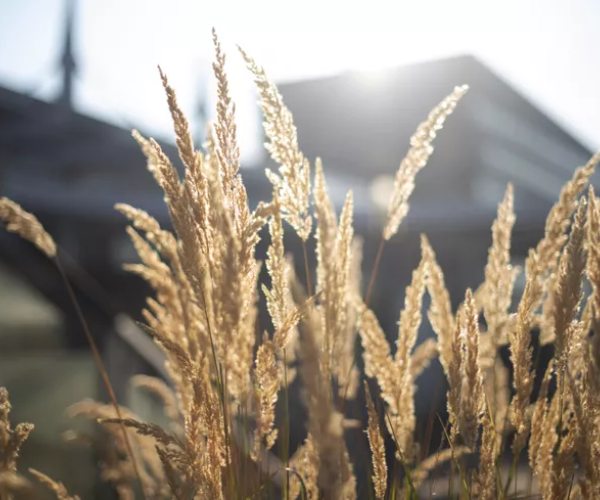Feather reed grass is often termed as an ornamental grass that stays upright all year long with dense clumps of tall and narrow green leaves, pink-purple flower spikes in the summer, and tan or golden seeds in the fall and early winter. This beautiful plant has a moderate growth rate and can survive in cooler climates as well. That said, it survives better in more heat once established. You can plant this ornamental grass in spring or fall. It needs rich, moist soil with full sun and the temperature shouldn’t be more than 105°F.
Plant Attributes
- Common Names: Feather reed grass, reed grass
- Botanical Name: Calamagrostis x acutiflora
- Family: Poaceae
- Plant Type: Perennial
- Mature Size: 3–5 ft. tall, 1.5–2.5 ft. wide
- Sun Exposure: Full
- Soil Type: Moist
- Soil pH: Acidic, Neutral, Alkaline
- Bloom Time: Summer, Fall
- Flower Color: Pink, Purple
- Hardiness Zones: 4-11 (USDA)
- Native Area: Europe, Asia
Feather Reed Grass Care
Grow healthy feather reed grass by following these main care needs:
- Plant the root ball in the ground or a pot at the same depth as its original container.
- Pick a location that receives full sun (at least six hours a day).
- Water at least once a week when the top inch of soil begins to dry out.
- The planting soil must be rich, moist, and well-draining. Clay soil and wet areas are also best.
- Plant in temperatures below 75°F.
- Mulching helps in winter to insulate from freezing temperatures.
- Fertilize once in the spring.
- Add organic mulch and compost to nutrient-poor soils.
- Cut to the ground at the end of winter before new growth appears.
Light
As mentioned earlier, feather reed grass does best in full sun and that is at least six hours of direct sunlight on most days. But it also likes some shade from the harsh afternoon sun, mostly in the warmer parts of the growing zones. But, if the shade is too much, the flowers won’t bloom profusely, the leaves get floppy and the plant’s overall size will be smaller.

Soil
This plant can tolerate different ranges of soil types. While it thrives in rich, consistently moist, well-draining soil, it also can be planted in heavy clay soil and wet areas of the landscape such as on the bank of a pond.
Water
This grass’s watering needs are moderate. It often requires watering but not too much. Only water it when the first one or two inches of the soil feels dry. Watering it once or twice a week is enough. Increase the frequency during hot days. Once established, these plants become somewhat drought tolerant but very dry soil will result in a plant that doesn’t grow too well.
Temperature and Humidity
What most don’t know is that the feather reed is a cool-season grass and doesn’t care for extreme heat. During planting, the temperatures should be below 75°F so it has enough time to establish a root system that will take in moisture before summer arrives. This plant can also survive temperatures below freezing by laying mulch over the plant in the northern parts of its growing zones to provide insulation during the winter. Unlike most plants, humidity isn’t that big of an issue for feather reed grass as long as it is getting good air circulation around the plant.
Fertilizer
Normally, feather reeds don’t need any supplemental fertilizer. However, organic mulch and compost mixed into the soil can benefit from extra nutrients. If your soil is poor, give it a balanced all-purpose plant food in the spring following the label instructions.
Types of Feather Reed Grass
There are a few popular varieties of feather reed:
- Calamagrostis x acutiflora ‘Karl Foerster’: This species is known for its neat, vertical growth habit and pink-purple to red-bronze flower spikes.
- Calamagrostis x acutiflora ‘Overdam’: This variety has white variegated leaves, and white flowers, and grows 2 to 3 feet tall.
- Calamagrostis x acutiflora ‘Avalanche’: The Avalanche variety has yellow variegated leaves and golden-brown flowers and grows 2 to 3 feet tall.
Pruning
Feather reed looks neat into winter and has stunning seed heads. Most growers wait until late winter or early spring to cut their feather reed grass to the ground. Just before new growth appears, shear it back so that you don’t accidentally hurt any new growth. Using sterilized pruning shears or a hedge trimmer, cut the previous season’s growth to a few inches above the soil line.

Also, Read Top 10 Poisonous Plants to Keep Out of Your Garden for Dog’s Safety
Propagating Feather Reed Grass
It is essential to propagate this plant by division every three to four years. While there is less chance that it won’t spread wildly in the landscape, a clump will continue getting larger through the rhizomes that spread underground. Even the clump requires division once so that sunlight and air won’t reach its center. Here is how you can do it:
- Use a shovel to dig up the clump of grass down to its roots.
- Pull apart smaller clumps of grass gently, keeping as many roots intact as possible. You can do it with the help of clean, sharp gardening shears.
- Dig separate holes in your new planting location at the same depth that the plant’s roots were previously growing.
- Replant your feather reed grass in the new holes and water and care for them as usual.
How to Grow Feather Reed Grass from Seed
This grass is normally not grown or propagated from its seeds. Since the plant is a hybrid, the seeds are sterile and won’t germinate. If you don’t know, sterile seeds mean that they won’t have any problem with your feather reed grass being invasive.
Potting and Repotting Feather Reed Grass
You already know by now that this plant makes a good ornamental grass for containers and it looks attractive when placed on a patio or deck that doesn’t get harsh sun. No matter the type of the pot, just make sure that the soil is well-draining and there are enough drainage holes in the container. Choose a clay pot to help with drainage further. Ensure that the pot is wide and also deep for the roots to accommodate a few years of growth before it requires a large pot.
For repotting a grass that has outgrown its previous container, choose one size larger and fill it with fresh potting mix. Be gentle while removing the plants. Loosen the roots a bit and then keep it in the new pot. Press gently around the firm with some extra soil and water to settle the plant easily.
Common Pests and Diseases
Feather Reed Grass rarely has problems with any disease or pests. You may encounter spider mites and aphids that can easily be eliminated using insecticidal soap.

Keep an eye out for fungal rust which can look like discoloration on the foliage and can happen after rainy spells. Therefore, it is essential to ensure good air circulation around the grass. A fungicide can also be helpful.
Common Problems With Feather Reed Grass
Once established, feather reed grass is fairly easy to care for and low-maintenance. While it’s one of the easiest ornamental grasses to grow and maintain, there can be some issues to watch for. Here are two problems you may face.
Browning Tips
If you notice the tips of your feather reed turning brown, you may either be underwatering or overfertilizing the plant. It is likely, not overwatered, as this type of grass usually doesn’t care about boggy soil.
No Plumes
If your feather reed is not bearing gorgeous plumes, it’s not getting enough sunlight. Another reason for grass without plumes may be that the soil has too much nitrogen. Amend the soil with high phosphorus fertilizer or bone meal.
FAQs
Q: What can be planted with feather reed grass?
Ans: Feather reed mixes well with other ornamental grasses and colorful wildflower perennials, such as black-eyed Susan, coneflower, and veronica. The narrow blossoms of the grass won’t compete with other showier blooms, but they do add texture and movement to a garden.
Q: What does feather reed grass look like in the winter?
Ans: The plumes of feather reed grass may last into winter, which adds vertical movement to an often dull winter landscape. Its plumes remain tan or golden into the late fall and winter.
Q: Will feather reed do well in a rain garden?
Ans: Because this grass likes boggy soil, it will do well in a rain garden where hummingbirds, butterflies, and other wildlife appreciate rain garden flowers. Plan to add colorful perennial plants that thrive in rain gardens such as black-eyed Susan, swamp milkweed, Joe Pye weed, and blue star.
Q: What’s the difference between feather reed grass and Mexican feather grass?
Ans: Though they are both ornamental grasses with similar names, they look entirely different from one another. Light-colored Mexican feather grass is delicate and droopy compared to the golden feather reed that grows more sturdy and upright.
Also, Read How to Grow and Care for Verbena Plants!
